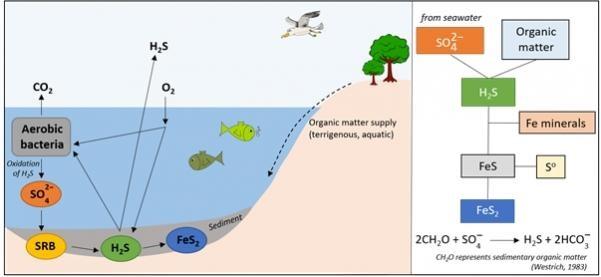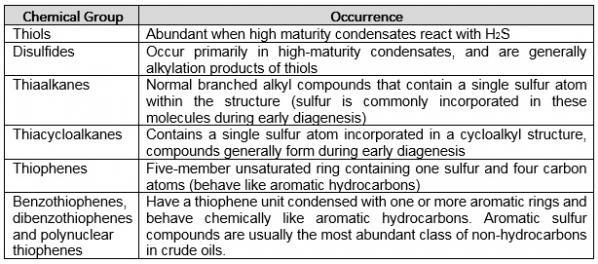Geochemistry of Sulfur in Petroleum exploration
Sulfur in Petroleum exploration
After Carbon and hydrogen, sulfur is the most abundant chemical element in petroleum, occurring at concentrations of over 10 wt% in some heavy oils. The increased use of sulfur-rich petroleums is increased in recent years. However, the environmental impact of sulfur combustion products has a growing interest in understanding the chemical nature of sulfur in the oil industry. Sulfur has an important role in petroleum geochemistry, in predicting the geological distribution of oils with high or low sulfur contents. Also has important implications for enhanced oil recovery and refining operations involving sulfur-rich Petroleums. There is a need for better characterization of the abundance and distribution of sulfur species in, for example, kerogens and asphaltenes.

There are numbers of factors to affect the concentration of sulfur in petroleum exploration. Among these are source characteristics (marine vs. terrestrial), presence or absence of dissolved sulfate, depositional environment (carbonate vs. elastic sequences).
Formation of sulfur-rich source rocks
Most primary sulfur in petroleum systems originates from early diagenetic reactions between deposited sedimentary organic matter and aqueous sulfide species. In environments where anoxic (low oxygen) conditions prevail, specific species of anaerobic microorganisms (sulfate-reducing bacteria) use the sulfate within the water body to oxidize organic molecules and produce hydrogen sulfide (H2S).
Within Siliclastic depositional environments, where dissolved iron species are usually in high abundance, the metals can remove the H2S by the formation of iron monosulfides (FeS, and iron pyrite (FeS2), resulting in low-sulfur kerogens and hydrocarbons.
However, in less clastic facies such as carbonate muds, the low concentration of dissolved iron inhibits the removal of H2S as iron sulfides, and the excess sulfide becomes incorporated into the kerogen. Sulfur-Sulfur (S-S) and Carbon-Sulfur (C-S) bonds are abundant in high sulfur kerogens and are more prone to cleavage at lower temperatures than Carbon-Carbon (C-C) bonds. This results in sulfur-rich source rocks generating petroleum at lower maturities than other kerogens. The initial oil expelled will have the maximum sulfur content, with sulfur content decreasing with increasing source rock maturity. it means Sulfur content in petroleum is denoting the low maturity of source rocks.

Sulfur in Petroleum and Bitumens
Sulfur content in crude oils and natural bitumens varies from less than 0.05 to more than 14 weight percent, but few commercially produced crude oils exceed 4% sulfur. Oils that have less than 1% sulfur are classified as low-sulfur, and that above 1 % as high-sulfur. In general, high-sulfur oils are derived from carbonate or carbonate-evaporite rock beds whereas low-sulfur oils are derived largely from clay-rich clastic sequences. Most of the sulfur present in crude oils and bitumens is organically bound because dissolved hydrogen sulfide (H2S) and elemental sulfur usually represent only a minor part of the total sulfur.
Sulfur in Kerogens and Asphaltenes
The sulfur content of the oil is determined primarily by the sulfur content of the source material kerogen. At the beginning of the oil generation, maximum sulfur content is present. Oil sulfur content decreases with the increasing maturity of oil, as a result of dilution by the further generation of non-sulfur compounds as well as by removal of sulfur.
Kerogen is defined as the fraction of sedimentary organic matter that is insoluble in common organic solvents. This operational definition provides a label or category for the material that is regarded as the major source material for oil and gas but does not imply a unique substance.
Kerogens, in fact, have a wide range of composition that depends on the original nature of the organic matter, conditions in the depositional environment, and the stage of evolution or maturity. Kerogens are considered as mixtures of complex biopolymers formed by condensation, polymerization, and crosslinking reactions of initial biogenic precursor materials. Sulfur may react with the biopolymers and precursor molecules and also may enter into the condensation cross-linking reactions forming kerogen with variations in sulfur content, depending on the depositional environment.
Sulfur in Natural Gas
Natural gases vary in H2S content from negligible amounts. Natural gases with high H2 S contents often also contain dissolved elemental sulfur and polysulfides. Gases with more than a few percent H2 S are generally limited to carbonate reservoirs at relatively high temperatures and in strata associated with evaporites. These rocks and associated waters furnish sulfate (from anhydrite) that can be reduced to H2S by bacteria at low temperatures and by thermochemical sulfate reduction at higher temperatures. So, rock strata are also the main factor in Sulphur rich Oil and natural gas
Also, read- Basic Petroleum Geology and Petroliferous basins of India
Future Expectations
Sulfur in petroleum exploration has many challenging opportunities for further research. Sulfur materials are still being investigated, and further evaluation of their character and their significance can be expected in the oil industry. An important opportunity related to petroleum exploration concerns
the nature of transformations of Oil Sulphur Content occurring between immature oils ( bitumens) and more mature crude oils. Easily identified Oil sulfur content in immature oils and bitumens are mainly alkyl thiolanes, alkylthianes, and alkyl thiophene whereas more mature crude oils (conventional crude oils) are dominated by rather low-molecular-weight benzo- and dibenzothiophenes. This difference signals potentially useful maturity reaction sequences in the Oil Sulphur Content that requires further investigation.

Further advances in various areas of OSC research can be expected in the next few years and many will be connected with continuing investigations of the mode of occurrence of sulfur in macromolecules (kerogens, asphaltenes, and resins). Determining the nature and abundance of polysulfide functions in kerogens, asphaltenes and resins remain a very important challenge in near future for sulfur in petroleum exploration.
Conclusion
High sulfur oils are relatively undesirable for the industry as they can typically be very heavy and viscous (due to the early-mature nature of the expelled fluids), and thus, difficult and costly to refine. Sulfur species are also poisonous for all catalytic processes. These can be temporary, although the full effects can be permanent depending on process conditions. Apart from this reduction in sulfur oxide emissions from the energy production and distribution sector is the main target for environmental agencies. Due to the large resources of heavy, sulfur-rich oils around the world, there may be a requirement to gain further insight into the most productive and environmentally friendly way to exploit sulfur-rich crude oil, thus Sulphur in petroleum exploration is very important.



